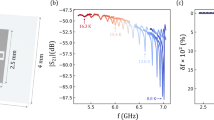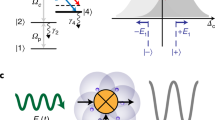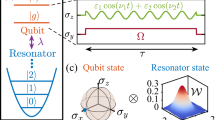Abstract
Magnetic monopoles1,2,3 are hypothetical elementary particles with quantized magnetic charge. In principle, a magnetic monopole can be detected by the quantized jump in magnetic flux that it generates upon passage through a superconducting quantum interference device (SQUID)4. Following the theoretical prediction that emergent magnetic monopoles should exist in several lanthanide pyrochlore magnetic insulators5,6, including Dy2Ti2O7, the SQUID technique has been proposed for their direct detection6. However, this approach has been hindered by the high number density and the generation–recombination fluctuations expected of such thermally generated monopoles. Recently, theoretical advances have enabled the prediction of the spectral density of magnetic-flux noise from monopole generation–recombination fluctuations in these materials7,8. Here we report the development of a SQUID-based flux noise spectrometer and measurements of the frequency and temperature dependence of magnetic-flux noise generated by Dy2Ti2O7 crystals. We detect almost all of the features of magnetic-flux noise predicted for magnetic monopole plasmas7,8, including the existence of intense magnetization noise and its characteristic frequency and temperature dependence. Moreover, comparisons of simulated and measured correlation functions of the magnetic-flux noise indicate that the motions of magnetic charges are strongly correlated. Intriguingly, because the generation–recombination time constant for Dy2Ti2O7 is in the millisecond range, magnetic monopole flux noise amplified by SQUID is audible to humans.
This is a preview of subscription content, access via your institution
Access options
Access Nature and 54 other Nature Portfolio journals
Get Nature+, our best-value online-access subscription
$29.99 / 30 days
cancel any time
Subscribe to this journal
Receive 51 print issues and online access
$199.00 per year
only $3.90 per issue
Buy this article
- Purchase on Springer Link
- Instant access to full article PDF
Prices may be subject to local taxes which are calculated during checkout




Similar content being viewed by others
Data availability
The data that support the findings of this study are available from the corresponding author upon reasonable request.
References
Dirac, P. Quantised singularities in the electromagnetic field. Proc. R. Soc. Lond. A 133, 60–72 (1931).
Hooft, G. Magnetic monopoles in unified gauge theories. Nucl. Phys. B 79, 276–284 (1974).
Polyakov, A. M. Particle spectrum in the quantum field theory. J. Exp. Theor. Phys. Lett. 20, 194–195 (1974).
Cabrera, B. First results from a superconductive detector for moving magnetic monopoles. Phys. Rev. Lett. 48, 1378–1381 (1982).
Ryzhkin, I. A. Magnetic relaxation of rare-earth pyrochlores. J. Exp. Theor. Phys. 101, 481–486 (2005).
Castelnovo, C., Moessner, R. & Sondhi, S. L. Magnetic monopoles in spin ice. Nature 451, 42–45 (2008).
Klyuev, A., Ryzhkin, M. & Yakimov, A. Statistics of fluctuations of magnetic monopole concentration in spin ice. Fluct. Noise Lett. 16, 1750035 (2017).
Kirschner, F. K. K., Flicker, F., Yacoby, A., Yao, N. & Blundell, S. J. Proposal for the detection of magnetic monopoles in spin ice via nanoscale magnetometry. Phys. Rev. B 97, 140402 (2018).
Castelnovo, C., Moessner, R. & Sondhi, S. Spin ice, fractionalization, and topological order. Annu. Rev. Condens. Matter Phys. 3, 35–55 (2012).
Jaubert, L. & Holdsworth, P. Magnetic monopole dynamics in spin ice. J. Phys. Condens. Matter 23, 164222 (2011).
Rosenkranz, S. et al. Crystal-field interaction in the pyrochlore magnet Ho2Ti2O7. J. Appl. Phys. 87, 5914–5916 (2000).
den Hertog, B. & Gingras, M. Dipolar interactions and the origin of spin ice in Ising pyrochlore magnets. Phys. Rev. Lett. 84, 3430–3433 (2000).
Ramirez, A., Hayashi, A., Cava, R., Siddharthan, R. & Shastry, B. Zero-point entropy in ‘spin ice’. Nature 399, 333–335 (1999).
Kaiser, V. et al. Emergent electrochemistry in spin ice: Debye–Hückel theory and beyond. Phys. Rev. B 98, 144413 (2018).
Burgess, R. E. The statistics of charge carrier fluctuations in semiconductors. Proc. Phys. Soc. B 69, 1020–1027 (1956).
van Vliet, K. M. & Fassett, J. R. Fluctuation Phenomena in Solids (ed. Burgess, R. E.) (Academic Press, 1965).
Mitin, V., Reggiani, L. & Varani, L. in Noise and Fluctuations Control in Electronic Devices Ch. 2 (American Scientific Publishers, 2002).
Konczakowska, A. & Wilamowski, B. M. in Fundamentals of Industrial Electronics Ch. 11 (Taylor and Francis, 2011).
Melko, R. G. & Gingras, M. J. P. Monte Carlo studies of the dipolar spin ice model. J. Phys. Condens. Matter 16, 1277–1319 (2004).
Vitale, S., Cavalleri, A., Cerdonio, M., Maraner, A. & Prodi, G. A. Thermal equilibrium noise with 1/f spectrum in a ferromagnetic alloy: anomalous temperature dependence. J. Appl. Phys. 76, 6332–6334 (1994).
Reim, W., Koch, R., Malozemoff, A., Ketchen, M. & Maletta, H. Magnetic equilibrium noise in spin-glasses: Eu0.4Sr0.6S. Phys. Rev. Lett. 57, 905–908 (1986).
Snyder, J. et al. Low-temperature spin freezing in the Dy2Ti2O7 spin ice. Phys. Rev. B 69, 064414 (2004).
Matsuhira, K. et al. Spin dynamics at very low temperature in spin ice Dy2Ti2O7. J. Phys. Soc. Jpn 80, 123711 (2011).
Yaraskavitch, L. R. et al. Spin dynamics in the frozen state of the dipolar spin ice material Dy2Ti2O7. Phys. Rev. B 85, 020410 (2012).
Kassner, E. R. et al. Supercooled spin liquid state in the frustrated pyrochlore Dy2Ti2O7. Proc. Natl Acad. Sci. USA 112, 8549 (2015).
Fennell, T. et al. Neutron scattering investigation of the spin ice state in Dy2Ti2O7. Phys. Rev. B 70, 134408 (2004).
Quilliam, J. A., Meng, S., Mugford, C. G. A. & Kycia, J. B. Evidence of spin glass dynamics in dilute LiHoxY1−xF4. Phys. Rev. Lett. 101, 187204 (2008).
Morris, D. et al. Dirac strings and magnetic monopoles in the spin ice Dy2Ti2O7. Science 326, 411–414 (2009).
Bramwell, S. T. et al. Measurement of the charge and current of magnetic monopoles in spin ice. Nature 461, 956–959 (2009).
Bovo, L., Bloxsom, J., Prabhakaran, D., Aeppli, G. & Bramwell, S. Brownian motion and quantum dynamics of magnetic monopoles in spin ice. Nat. Commun. 4, 1535–1542 (2013).
Giblin, S., Bramwell, S., Holdsworth, P., Prabhakaran, D. & Terry, I. Creation and measurement of long-lived magnetic monopole currents in spin ice. Nat. Phys. 7, 252–258 (2011).
Kaiser, V., Bramwell, S. T., Holdsworth, P. C. W. & Moessner, R. ac Wien effect in spin ice, manifest in nonlinear, nonequilibrium susceptibility. Phys. Rev. Lett. 115, 037201 (2015).
Paulsen, C. et al. Experimental signature of the attractive Coulomb force between positive and negative magnetic monopoles in spin ice. Nat. Phys. 12, 661–666 (2016).
Metropolis, N., Rosenbluth, A. W., Rosenbluth, M. N. & Teller, A. H. Equation of state calculations by fast computing machines. J. Chem. Phys. 21, 1087–1092 (1953).
Eyvazov, A. B. et al. Common glass-forming spin liquid state in the pyrochlore magnets Dy2Ti2O7 and Ho2Ti2O7. Phys. Rev. B 98, 214430 (2018).
Takatsu, H. et al. AC susceptibility of the dipolar spin ice Dy2Ti2O7: experiments and Monte Carlo simulations. J. Phys. Soc. Jpn 82, 104710 (2013).
Acknowledgements
We are grateful to C. Castelnovo, J. Goff, Y. B. Kim, M. J. Lawler, A. Ramirez, D. Schlom and N. Y. Yao for discussions and communications. J.C.S.D. thanks O. H. S. Davis for discussions and for proposing to study magnetic noise in pyrochlores. R.D. thanks Y. X. Chong for assistance during experimental operations and acknowledges use of the Cornell Center for Materials Research Shared Facilities, supported through the NSF MRSEC programme (DMR-1719875). A.E. acknowledges support via Israeli Pazy Equipment Grant 299/18. F.K.K.K. acknowledges support from Lincoln College, Oxford. F.F. acknowledges support from the Astor Junior Research Fellowship of New College, Oxford. S.J.B. acknowledges support from EPSRC (EP/N023803/1). The conceptual design of our experimental techniques was supported by the W. M. Keck Foundation. J.C.S.D. acknowledges support from Science Foundation Ireland under Award SFI 17/RP/5445 and from the European Research Council (ERC) under award DLV-788932. R.D. and J.C.S.D. acknowledge support, plus funding for instrument development and experimental studies, from the Gordon and Betty Moore Foundation’s EPiQS Initiative through grant GBMF4544.
Author information
Authors and Affiliations
Contributions
R.D. and J.C.S.D. conceptualized the project and designed the experimental setup. R.D. developed the flux noise spectrometer. R.D., J.C.H., B.R.R. and A.E. carried out the experiments and data analysis. G.M.L. synthesized the Dy2Ti2O7 samples. F.K.K.K. carried out the Monte Carlo simulations with help from F.F. G.M.L., S.J.B. and J.C.S.D. supervised the investigation and wrote the paper with key contributions from R.D., F.K.K.K. and F.F. The manuscript reflects the contributions of all authors.
Corresponding authors
Ethics declarations
Competing interests
The authors declare no competing interests.
Additional information
Publisher’s note: Springer Nature remains neutral with regard to jurisdictional claims in published maps and institutional affiliations.
Extended data figures and tables
Extended Data Fig. 1 Sensitivity calibration of magnetic-flux noise spectrometer.
Here we show the linear relationship between a flux applied to the pickup coil via a drive coil (Φapplied) and flux output by the SQUID (Φmeasured). The slope gives the transfer function between the pickup coil and the SQUID.
Extended Data Fig. 2 Comparison of Dy2Ti2O7 magnetic-flux noise with background noise.
Typical spectrum of magnetic-flux noise spectral density from a Dy2Ti2O7 sample (at 1.22 K) compared with that of an empty pickup coil corresponding to ~16.8 × 10−12Φ02 Hz−1. The black data points have been shifted vertically for clarity. Error bars represent the standard deviation of each data point, extracted from an average of five independent Dy2Ti2O7 flux noise datasets.
Extended Data Fig. 4 Comparison of magnetic-flux noise from different Dy2Ti2O7 samples.
Plot of magnetic-flux noise SΦ(ω, T) from two different rod-shaped Dy2Ti2O7 samples. We observe that the SΦ(ω, T) distributions are very similar and therefore this experiment is qualitatively repeatable for single crystals of Dy2Ti2O7. The differences in magnitude and time constant are due to the geometrical differences between the two samples.
Extended Data Fig. 5 Magnetization relaxation time constants from flux noise spectra.
Time constant obtained from fits to the measured SΦ(ω, T) data shown in Fig. 3. The time constant τ(T) derived from the flux noise behaves in a super-Arrhenius fashion, τ(T) = τ0exp[DT0/(T – T0)], consistent with previous measurements of a.c. susceptibility time constants τM(T) (ref. 35), which also exhibited super-Arrhenius behaviour with τ0 ≈ 1.4 × 10−4 s, D ≈ 14, T0 ≈ 0.26 K.
Extended Data Fig. 6 Variance of Dy2Ti2O7 magnetic-flux noise versus temperature.
Measured variance of flux \({\sigma }_{{\Phi }}^{2}\), showing that it is approximately constant as a function of temperature in the range displayed.
Supplementary information
Rights and permissions
About this article
Cite this article
Dusad, R., Kirschner, F.K.K., Hoke, J.C. et al. Magnetic monopole noise. Nature 571, 234–239 (2019). https://doi.org/10.1038/s41586-019-1358-1
Received:
Accepted:
Published:
Issue Date:
DOI: https://doi.org/10.1038/s41586-019-1358-1
This article is cited by
-
Anomalous magnetoresistance by breaking ice rule in Bi2Ir2O7/Dy2Ti2O7 heterostructure
Nature Communications (2023)
-
Magnetic monopole density and antiferromagnetic domain control in spin-ice iridates
Nature Communications (2022)
-
Two-dimensional magnetic monopole gas in an oxide heterostructure
Nature Communications (2020)
Comments
By submitting a comment you agree to abide by our Terms and Community Guidelines. If you find something abusive or that does not comply with our terms or guidelines please flag it as inappropriate.



